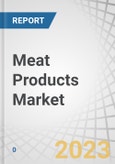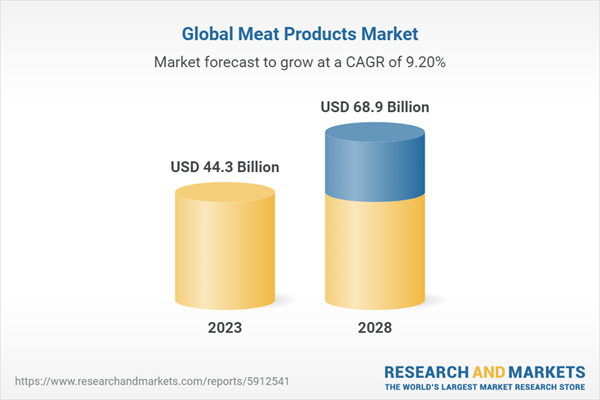The meat products market is projected to grow from USD 44.3 Billion in 2023 to USD 68.9 Billion by 2028, at a CAGR of 9.2% during the forecast period. The ascendancy of retail distribution channels within the meat market is underscored by several compelling factors. Fundamental to this dominance is the tactile engagement inherent in retail environments, affording consumers the opportunity to meticulously inspect and personally select their meat, thereby instilling a paramount sense of trust in the quality and freshness of the products. A pivotal driver is the immediacy of gratification facilitated by retail, a distinct advantage over the delayed delivery processes associated with e-commerce. The prevalence of customization and personalization options at butcher counters further substantiates the favorability of retail.
Social and cultural considerations, wherein the act of selecting meat is viewed as a communal or familial undertaking, further bolster retail's standing. In-store promotional initiatives, sampling opportunities, and the cultivation of brand loyalty collectively reinforce the preeminence of retail. Command over supply chains, the ability to offer localized and seasonal products, adherence to perceived hygiene standards, and the unparalleled convenience and accessibility of retail outlets coalesce to solidify their dominance over food service and e-commerce alternatives in the meat market.
During the projected period, the organic category within nature is anticipated to exhibit the most rapid growth, boasting the highest Compound Annual Growth Rate (CAGR).
The demand for organically raised meat is experiencing a significant upswing as consumers increasingly prioritize health, sustainability, and ethical farming practices. In recent years, there has been a discernible shift in consumer behavior, with a growing awareness of the environmental and health implications associated with conventionally produced meat.
Organically raised meat is garnering attention for its commitment to eschewing synthetic pesticides, antibiotics, and growth hormones. Consumers are increasingly drawn to the assurance of a product that is free from potentially harmful additives, promoting a cleaner and more natural source of nutrition. Moreover, organic farming practices emphasize animal welfare and sustainable land management, aligning with the values of socially conscious consumers.
The rise in demand can also be attributed to a broader societal trend towards embracing a holistic approach to well-being. As individuals become more health-conscious and environmentally aware, they are actively seeking out food options that align with their values. This surge in demand not only reflects a desire for healthier dietary choices but also signifies a broader shift towards supporting agricultural practices that prioritize long-term ecological sustainability.
In response to this escalating demand, the organic meat sector is witnessing increased investment and innovation, ensuring that consumers have access to a diverse range of high-quality, ethically produced meat products. This trend underscores the growing importance of transparency and conscientious decision-making in the modern food industry. In March 2021, Cargill introduced poultry meat to the Chinese market that is raised without the use of antibiotics, catering to the needs of consumers seeking organic meat options.
Pork stands as the Culinary Cornerstone, ranking second in dominance within the animal type segment of the meat products market.
Pork, sourced from domestic pigs, holds a significant place in the world of cuisine, rooted in a rich history across diverse global food traditions. Its adaptability in various cuts and cooking methods has solidified its presence on dining tables worldwide. Whether in the form of juicy pork chops, flavorful bacon, or savory sausages, pork caters to a wide range of taste preferences. Packed with essential nutrients like protein, B vitamins, iron, and zinc, pork plays a crucial role in promoting balanced diets. Its cost-effectiveness makes it an appealing choice for budget-conscious consumers, contributing to its widespread popularity.
The increasing demand for pork can be attributed to several factors, such as its culinary versatility, affordability, and nutritional benefits. As awareness of the importance of a balanced diet grows, consumers are turning to pork as a nutritious and readily available source of protein. This rising demand, observed in both traditional and emerging markets, has driven innovation in the meat products sector. Manufacturers are expanding their product offerings, introducing new and refined pork-based products to meet changing consumer preferences. This growth not only enhances the economic prospects of the pork industry, encompassing production, processing, and distribution but also stimulates global trade in meat products, highlighting pork's pivotal role in shaping the current landscape of the meat market.
Changes in dietary choices have positioned the Asia-Pacific region as a dominant force in the meat products market.
The Asia Pacific meat products market has undergone substantial expansion in recent years, spurred by various factors influencing the escalating demand for such commodities. Notably, in densely populated nations like India and China, burgeoning urbanization and a rising middle class with increased disposable income have precipitated a shift in dietary preferences towards protein-rich options, propelling the demand for meat products. Simultaneously, Japan, Australia, and New Zealand, characterized historically by distinct dietary patterns, have experienced a surge in domestic meat consumption, driven by changing lifestyles, a preference for locally sourced products, and a growing appetite for convenience and processed meat offerings.
The market landscape in the Asia Pacific region reflects a diversified array of meat products, encompassing fresh, processed, and value-added categories. This diversification is a response to shifting consumer preferences, with an increasing emphasis on premium and specialty meat products. Technological advancements and improvements in supply chain infrastructure have played pivotal roles in the industry's evolution, ensuring the efficient and safe distribution of meat products. As cold chain logistics continue to mature, facilitating seamless transportation from production centers to diverse consumer markets, the Asia Pacific meat products market stands poised for sustained growth, fueled by a confluence of demographic, economic, and cultural factors.
Nations like China and India play host to diverse manufacturing bases, constituting significant contributors to both meat imports and regional production. Based on OECD library data, there has been an upward trajectory in poultry meat production across the Asia Pacific region, escalating from 60,964.73 tonnes in 2019 to 53,538.34 tonnes in 2022. The ready availability of raw feed materials has spurred the establishment of local manufacturers and processing units in the region, enabling numerous companies to consolidate their positions in an import-oriented market, predominantly geared towards exports.
The break-up of the profile of primary participants in the meat products market:
- By Company Type: Tier 1 - 25%, Tier 2 - 45%, and Tier 3 - 30%
- By Designation: CXOs - 20%, Managers - 50%, Executives- 30%
- By Region: North America - 25%, Europe - 25%, Asia Pacific - 40%, and Rest of the World -10%
Prominent companies Cargill, Incorporated (US), JBS SA (Brazil), Tyson Foods, Inc. (Arkansans), Hormel Foods Corporation (US), Vion Group (Netherlands) among others.
Research Coverage:
This research report categorizes the meat products market by Animal type (Beef, Pork, Poultry), Type (Processed, Frozen, Canned, Chilled, Fresh), Distribution Channel (Retail, Food Service, E-commerce), Nature (Conventional, Organic), Packaging (Fresh Meat packaging, Vaccum Packaging, Modified Atmosphere Packaging), End Use (Commercial, Household) and Region (North America, Europe, Asia Pacific, RoW). The report covers information about the key factors, such as drivers, restraints, opportunities, and challenges impacting the growth of the meat products market. It also provides a detailed analysis of the major players in the market including their business overview, products offered; key strategies; partnerships, new product launches, and acquisitions. Competitive benchmarking of upcoming startups in the meat products market is covered in this report.
Reasons to buy this report:
The report will help the market leaders/new entrants in this market with information on the closest approximations of the revenue numbers for the overall meat products market and the subsegments. This report will help stakeholders understand the competitive landscape and gain more insights to position their businesses better and plan suitable go-to-market strategies. The report also helps stakeholders understand the pulse of the market and provides them with information on key market drivers, restraints, challenges, and opportunities.
The report provides insights on the following pointers:
- Analysis of key drivers (Growing awareness of nutritional value of meat, Rising demand for meat-based convenience foods), restraints (Multiple incidences of disease outbreaks, Growing trend of veganism), opportunities (Technological advancements in meat processing industries), and challenges (Fluctuations in feed prices and labor costs) influencing the growth of the meat products market.
- Product Development/Innovation: Detailed insights on upcoming technologies, research & development activities, and new product & service launches in the meat products market.
- Market Development: Comprehensive information about lucrative markets - the report analyses the meat products market across varied regions.
- Market Diversification: Exhaustive information about new products & services, untapped geographies, recent developments, and investments in the meat products market.
- Competitive Assessment: In-depth assessment of market shares, growth strategies, and service offerings of leading players like Cargill, Incorporated (US), JBS SA (Brazil), Tyson Foods, Inc. (Arkansans), Hormel Foods Corporation (US), Vion Group (Netherlands), Maple Leaf Foods (Canada), Danish Crown Vej (Denmark), Marfrig Global Foods S.A. (Brazil) among others in the meat products market strategies. The report also helps stakeholders understand the meat products market and provides them with information on key market drivers, restraints, challenges, and opportunities.
Table of Contents
Companies Mentioned
- Allen Harim
- Associated British Foods plc
- Baiada
- Cargill, Incorporated
- Cremonini S.P.A
- Danish Crown Vej
- Hormel Foods Corporation
- JBS SA
- Kreata Makedonias
- Lopez Foods, Inc
- Maple Leaf Foods
- Marfrig Global Foods S.A.
- MB Specialties
- Minerva Foods Sa
- Noel Alimentaria, S.A.U.
- Plukon Food Group
- R. Whittingham & Sons Meat Co.
- Resource Agribusiness Group
- Sloga Prom
- Tyson Foods, Inc.
- Uw Provision Company
- Verde Farms
- Vion Group
- Voudouris-Konstas Sa
- YMF Global
Table Information
| Report Attribute | Details |
|---|---|
| Published | November 2023 |
| Forecast Period | 2023 - 2028 |
| Estimated Market Value ( USD | $ 44.3 Billion |
| Forecasted Market Value ( USD | $ 68.9 Billion |
| Compound Annual Growth Rate | 9.2% |
| Regions Covered | Global |
| No. of Companies Mentioned | 25 |









